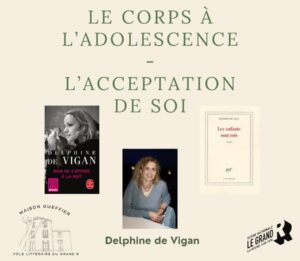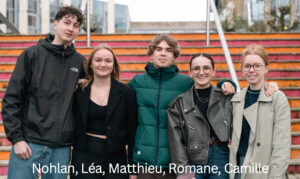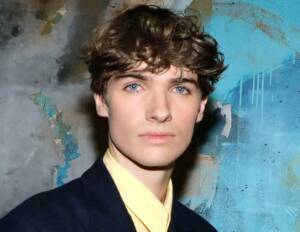Interview de David OReilly
Né en 1985 à Kilkenny, Irlande
Premier short-movie connu : WOFL2106 (apparition de memes du moment)
2007 : Sons of Rainbow
Réalisateur invité pour l’épisode “A glitch is a glitch” d’Adventure Time (scénario, production, réalisation
Film Her de Spike Jonze (création du personnage et de l’univers virtuel)
Jeux-vidéos : Mountain (2014) et Everything (2017)
Nombreux prix pour ses courts-métrages : Ours d’Or Berlin International Film Festival 2009 Please Say Something , best animated short-movie Sundance Film Festival 2011 for The External World
L’aventure Octocat : En 2008 un jeune garçon de 9ans “RANDYPETERS1” poste sur Youtube les dessins d’un chat aux longs bras cherchant ses parents → 5 épisodes avec pour le dernier des images en 3D → le garçon est en fait David O’Reilly !
Version originale :
→ How do you like it here at La Roche-sur-Yon?
It is my first time at La Roche-sur-Yon. I am having a wonderful time. It feels like a gigantic festival, compressed into the city. I am having a wonderful experience, to keep it short. I’m just really enjoying this.
→ How do you like the exhibition of your work and its management by the art school?
Well, this exhibition blew me away. Because, actually I had a little to do with it. It’s an amazing production by the team here. I’ve never seen anything like it before. And it‘s not only this beautiful presentation of the work, but it’s translated into french for the first time. And they’ve produced this amazing book to accompany it. Of course, it’s like a complicated thing when you see all of your work together. When you make something, you train yourself to scan for the problems and errors in it. When I see my work, particularly early work, I kind of cringe and I find it difficult to enjoy. But at the same time, the festival really wanted to do a comprehensive collection, retrospective of work. I even know the direct experience of being confronted to its project, it’s really difficult for me personally. I really like the kind of depth, the wide spectrum that’s on display. You can see a progression and you can see the flaws that are not so flawed. And that’s important too. It’s good to be able to see an artist’s mistakes, the paths that every artist takes, which is never a straight line. I hope people will like it.
→ What pushed you to start creating animated movies?
I fell in love with animation when I was a teenager. I was exposed to animation like every child is, but when I saw the artists working in it, I became really interested. When I saw the work of people like Oscar Fischinger and Norman McLaren, who are these very unique individuals in animation landscape, who treated it like a medium of expression as a sort of carriers of these ideas and techniques that nobody else was doing. They were just these independant figures that were able to create these amazing things by themselves. That was very appealing to me. I love that side of it. And then I also fell in love with the Disney work. When I started learning the techniques of animation, I grew this appreciation for movement, all of the visual components of animation. When you learn to draw, it changes how you look at things. And when you start learning animation, you also start seeing movement in a new way. So it sort of changes the way I look at the world, as I got deeper and deeper into it. I just felt like it’s just the best medium in the world!
→ You have directed a whole episode of “Adventure Time”, an animated movie that a lot of children and teens know, you posted the octocat adventure on youtube as a 9 year-old boy. Would you say that you are an eternal child inside?
I think the more advanced you get in any creative field, the more careful you become and the more you appreciate the kind of freedom that a child exhibits and how they create, that unself censure, unself conscious, bold and brave kind of spirit that every child has. It’s kind of like you get the situation where the more advanced you get, the more you appreciate the simple and the kind of crude. I definitely think that for every artist, you get the point when you got to cultivate that sort of freedom. A child-like approaches of life is as valuable as a kind of advanced approaches. And I think people find it appealing too, when something has a child-like spirit. It’s less intimidating. It has a feeling that it reaches people in a very deep way, so yes.
→ You’ve worked a lot with internet, do you think that internet is the future of art creation and art spreading?
I think that internet is the present of art communication and art spreading and it’s of course the future of that. Internet is the present of all information sharing, and the future. I don’t know exactly what the future holds, but it will certainly evolved into an internet ecosystem, and I feel that is something that it is not going away soon.
→ In 2014, you created the Mountain video-game, your first one. Why did you choose to experience this special type of creation?
I’ve always been interested in artificial image, and I was exploring that in design and animation. I just started to become curious about this new form of 3D. So I started to just play with the software, without any real aim, just having fun with it. And then I started to get ideas that I felt would work inside that medium. Once that happened, I started making them and that’s it ! It was for me another thing that I got very addicted to. It happened at the time when somebody like me who wasn’t a programmer could work with tools that were more artist-friendly. I started creating at that point, when it was basically possible to do more art projects with it.
→ Would you say that video-game is a proper form of art?
Of course, absolutely ! But the proper form of art is something that everybody decides individually. Many people think that cinema is not a form of art, many people think that contemporary art is not real art, it’s a very subjective thing. But for me, it’s very obviously. It’s a carrier of ideas, it’s a place for persons to arrange their thoughts, feelings and ideas. It allows for a sort a transfer of experience and all of the things that you could expect from a work of art.
→ Did you play video-games when you were a child? Which one? And now?
I played gameboy, a little bit and I had a playstation for a while. But most of my childhood, I was not really allowed playing games. They were not as much part of my childhood, as some of my friends who make games. That’s something I discovered mostly in my twenties. After I had already started animation, I started to take a look at games. Now it’s more part of my life, yes. It’s a very active field and there are so many things coming out every year, very ambitious projects that I can’t resist trying. I haven’t actually played a game in maybe eight months or something, since finishing my game and making sure that was totally finished. And taking a break now, it’s more part of my life.
Traduction :
→ Appréciez-vous votre venue à la Roche-sur-Yon?
C’est la première fois que je viens à la Roche-sur-Yon. Je passe un superbe moment. C’est un gigantesque festival, concentré dans la ville. C’est une expérience géniale pour moi, pour faire court. J’apprécie vraiment être ici.
→ Appréciez-vous l’exposition de votre travail et son aménagement par l’école d’art?
Et bien, cette exposition m’a scotché. Parce qu’en fait, je n’ai pas eu grand chose à faire. C’est une incroyable production réalisée par l’équipe de l’école d’art. Je n’avais jamais rien vu de pareil avant. Et ce n’est pas seulement une belle présentation de mon travail, mais c’est aussi la première fois qu’il est adapté en français. Et l’équipe a produit ce livre génial pour l’accompagner. Bien sûr, c’est compliqué de voir tout son travail rassemblé. Quand on crée quelque chose, on s’entraîne à scanner les problèmes et les erreurs. Quand je regarde mon travail, particulièrement mes débuts, ça me révulse un peu et j’ai du mal à l’apprécier. Mais en même temps, le festival voulait vraiment faire une rétrospective compréhensible. Je connais ce sentiment d’être confronté directement à son propre travail et c’est difficile pour moi personnellement. J’aime beaucoup la profondeur, le spectre large qu’offre l’exposition. On peut voir une progression, les erreurs qui ne sont pas si imparfaites que ça. Et c’est aussi important. C’est bien d’avoir la possibilité de voir les erreurs d’un artiste, les chemins que chaque artiste prend, car ce n’est jamais une ligne toute tracée. J’espère que les gens vont apprécier.
→ Qu’est-ce qui vous a poussé à la création de films d’animation?
Je suis tombé amoureux de l’animation quand j’étais adolescent. J’ai été exposé à l’animation, comme tous les enfants. Mais quand j’ai vu les artistes travaillant dessus, ça m’a vraiment intéressé. Quand j’ai vu le travail d’Oscar Fischinger et Norman McLaren, des individus uniques dans le paysage de l’audiovisuel qui la traitait comme un moyen d’expression, comme porteuse de ces idées et de techniques que personne n’avait. Ils étaient ces figures indépendantes capables de créer d’incroyables choses par eux-mêmes. C’était très attirant. J’aime cet aspect de l’animation. Et puis, je suis aussi tombé amoureux du travail de Disney. Quand j’ai commencé à apprendre les techniques de l’image animée, j’ai développé cette appréciation du mouvement, toutes les composantes de l’animation. Quand on commence à dessiner, notre regard sur les choses change. Et quand on commence à apprendre l’animation, on appréhende le mouvement d’une manière différente.
Donc, ça a changé en quelque sorte la manière dont je regarde le monde, au fur et à mesure que j’approfondissais mes connaissances. J’avais juste l’impression que c’était le meilleur média du monde !
→ Vous avez réalisé un épisode entier d’ “Adventure Time”, un dessin-animé que beaucoup d’enfants et d’adolescents connaissent, vous avez posté “les aventures d’Octocat” sous l’identité d’un garçon de 9 ans. Diriez-vous que vous êtes un éternel enfant à l’intérieur?
Je pense que plus on avance, dans n’importe quel type de création, plus on fait attention et plus on apprécie cette sorte d’affranchissement que l’enfant exhibe et sa manière de créer, sans censure personnelle, sans conscience personnelle, l’intrépide état d’esprit de tous les enfants. C’est-à-dire que plus on avance, plus on aime la simplicité, cet “état brut”. Je pense réellement que pour chaque artiste, il y a ce moment où l’on doit cultiver cette sorte de liberté. Une approche “enfantine” de la vie vaut autant que des approches plus évoluées. Et je pense que les gens sont attirés par l’esprit enfantin de certaines choses. C’est moins intimidant. Ca touche les gens de manière profonde.
→ Vous avez beaucoup travaillé sur internet, pensez-vous que c’est le futur de la création et de la diffusion artistique?
Je pense qu’internet est le présent de la communication et la diffusion de l’art et c’est bien entendu son futur. Internet est le présent de tout le partage d’informations et son futur. Je ne sais pas vraiment de quoi sera fait le futur, mais il va certainement évoluer vers un écosystème internet et n’est pas amené à disparaître tout de suite.
→ En 2014, vous avez créé le jeu vidéo Moutain, votre premier. Pourquoi avoir choisi d’expérimenter cette forme spéciale de création?
J’ai toujours été intéressé par l’image artificielle et je l’expérimentais déjà avec le design et la création. J’ai juste fait le curieux à propos de cette nouvelle forme de 3D. Donc j’ai simplement commencé à jouer avec le logiciel, sans réel but, juste pour m’amuser. Et puis sont venues des idées qui pouvaient coller à ce médium. Quand c’est arrivé, j’ai commencé à faire des jeux, et c’est tout ! C’était pour moi encore quelque chose qui me rendait addict. Ca s’est passé au moment où quelqu’un comme moi, qui n’était pas programmeur, pouvait travailler avec des outils plus adaptés pour les artistes. J’ai commencé à travailler à ce moment là, quand c’est devenu possible de faire plus de projets artistiques avec cette technologie.
→ Diriez-vous que le jeu-vidéo est une forme d’art à part entière?
Bien sûr, absolument ! Mais la notion d’art est quelque chose que chacun décide individuellement. Beaucoup de gens pensent que le cinéma n’est pas une forme d’art, beaucoup que l’art contemporain n’est pas vraiment de l’art, c’est très subjectif. Mais pour moi, le jeu-vidéo, c’est évident. C’est un support d’idées, un endroit où les gens organisent leurs pensées, sentiments et idées. Cela permet une sorte de transfert d’expérience et tout ce qu’on peut attendre d’une oeuvre d’art.
→ Jouiez-vous aux jeux-vidéos quand vous étiez petit? Et maintenant?
J’ai joué à la gameboy, j’ai eu une playstation il y a longtemps. Mais durant une grande partie de mon enfance je n’avais pas le droit de jouer aux jeux vidéos. Les jeux vidéos n’ont pas vraiment fait partie de mon enfance, comparé à certains de mes amis qui développent des jeux-vidéos. C’est quelque chose que j’ai plutôt découvert vers mes vingt ans. J’ai commencé à m’y intéresser alors que j’avais déjà commencé l’animation. Maintenant, ils font beaucoup plus partie de ma vie. C’est un domaine très actif, avec des nouveautés qui sortent tous les ans, des projets ambitieux que je ne peux résister de tester. En réalité, je n’ai pas joué aux jeux-vidéos depuis peut-être huit mois ou plus, depuis que j’ai finit mon jeu, que je me suis assuré qu’il était vraiment terminé. Et maintenant que je fais une pause, ça occupe un peu plus mon quotidien.
Julie Armouet




